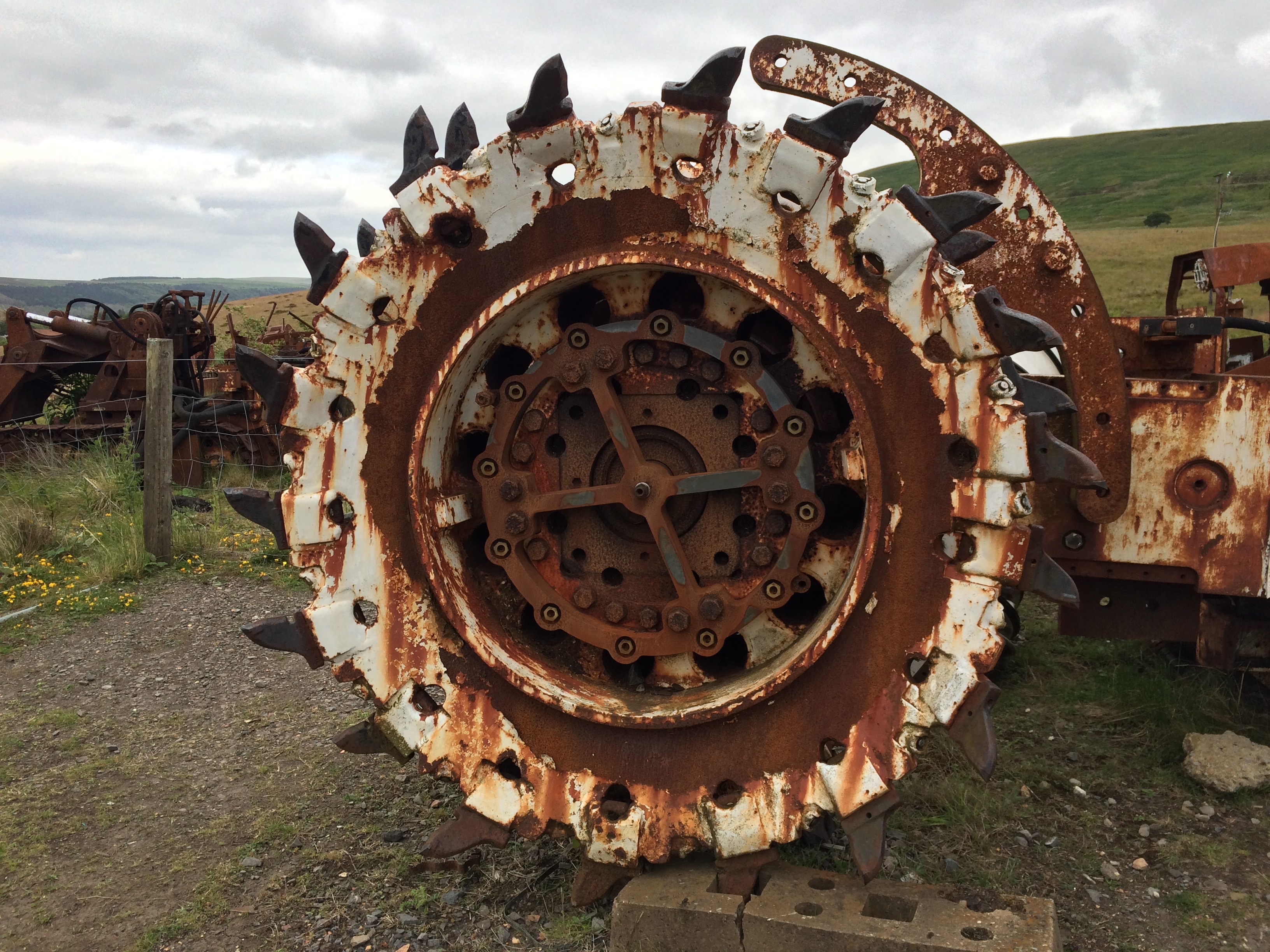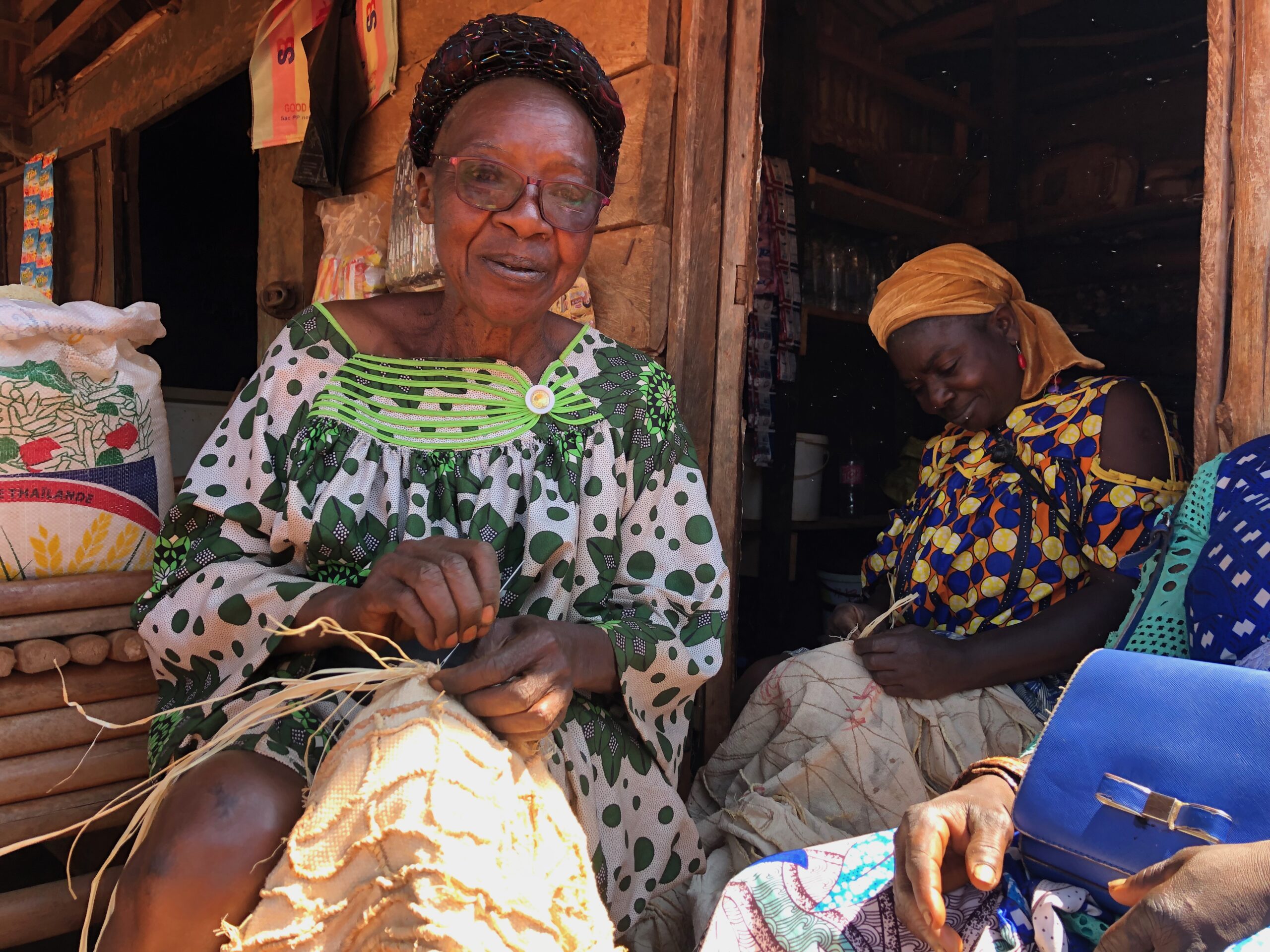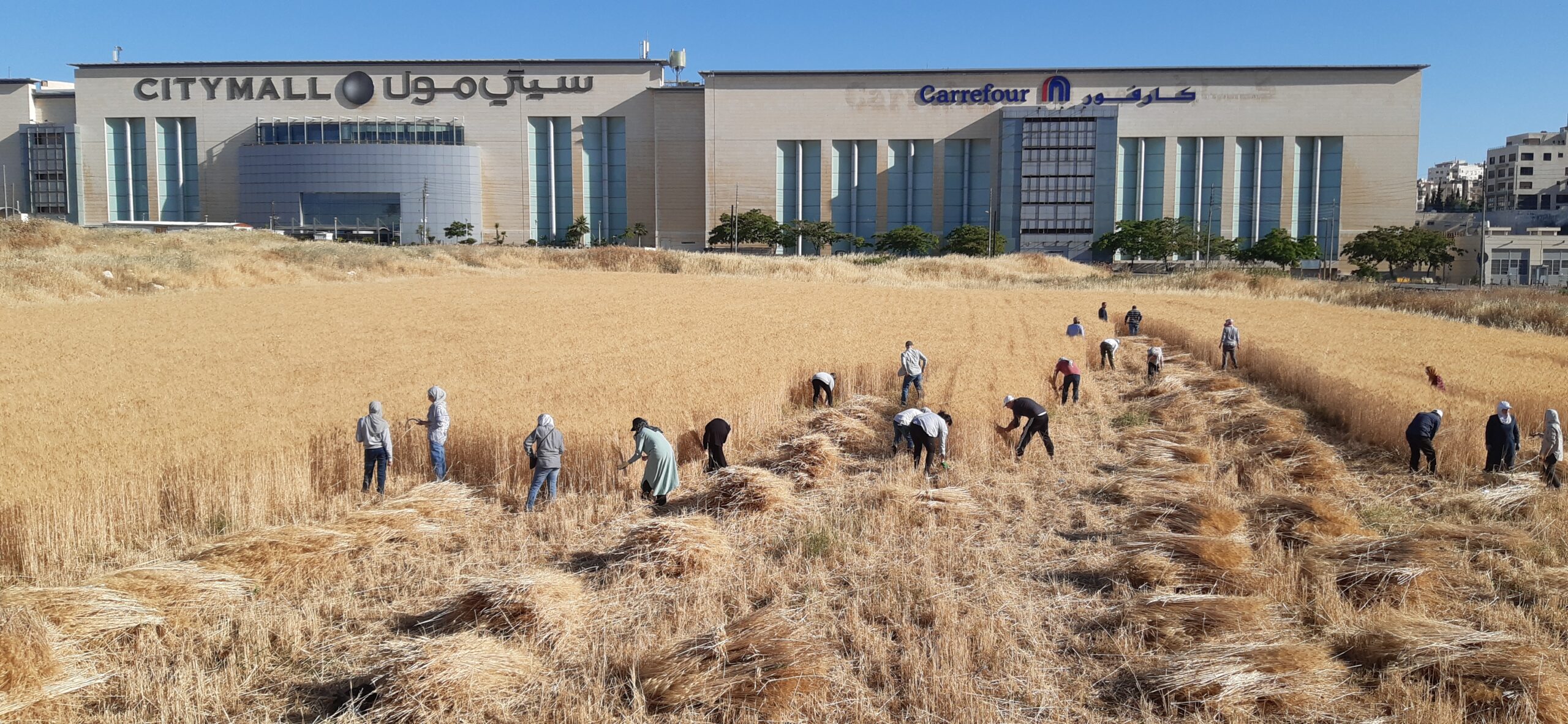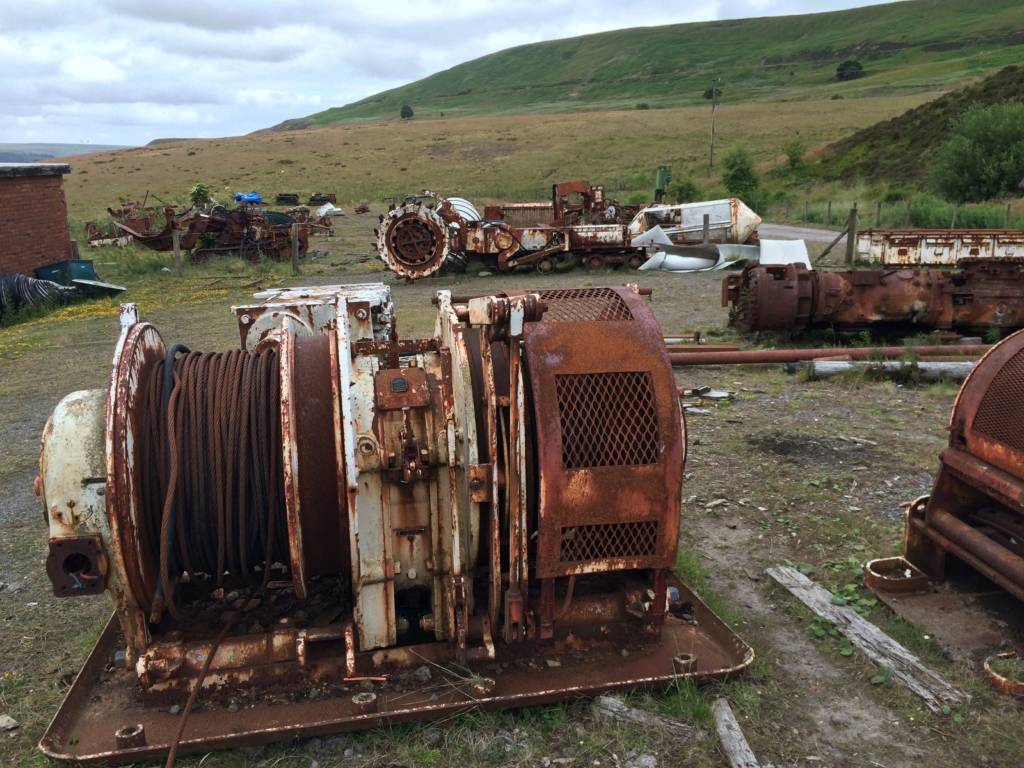
We thought it was just going to be a tour of the defunct coal mine’s aboveground facility, which was already troubling enough. The winding wheels and framework for the conveyor system at the “pit head” were like the superstructure of an abandoned carnival, like the one I’d read about near Chernobyl. Retired earth-eating equipment had been hauled out to the persistent drizzle of the surface world, strewn in state across the healing landscape, a disfigured Cadillac Ranch radiating from the village-like cluster of grim stone buildings and low white barns. An occasional bird touched down nervously on some rusting apparatus, but there was little evidence of life or sound other than the hum of the raw westerly flowing from the Irish Sea across the Brecon Beacons.
This was Wales, but it felt a little like the preserved battlefields we had recently visited in France, replete with their collapsed bunkers, depressions from artillery explosions softened by a century and grass. But here, there were no prohibitive fences, no signs warning of unexploded ordinance. This was a place where people had worked instead of deliberately murdering each other, after all. Where functional albeit diabolical metal became a curiosity, a monument after its operator dismounted and walked away into a changed world. Out there in the rocky meadow adjacent to the mine, I could actually place my palm on the blunt teeth of a particularly rapacious looking gang of toothed circular blades, a gesture akin to petting the maw of a block-and-tackled trophy shark. Actually, it reminded me more of the habit some people have of stroking the rivets of a jet’s fuselage while stepping through the hatchway into the cabin, before the attendant secures the door, clamping the lever into place.
It was summer. We were on the last leg of an aesthetically challenging tour of the World War I trail, but also the key sites of the Industrial Revolution. My wife, a history teacher, had received a grant from her school to do some research. I was tagging along as chauffeur and underprepared literary consultant on a gritty pilgrimage that had begun in the foothills of the Vosges near France’s border with Germany. Propelled by a shuddering, tiny Renault across the superheated agricultural interior (sewing machine for an engine, no AC), we swung up to Belgium, to Ypres and Paschendael, then exited Europe through the rabbit warren of temporary chain-link barricades surrounding the refugee camps in Calais. It was the year when the ferry workers were in some sort of dispute, and lorries intending to haul freight across to the UK were backed up for hours on the highways outside the port. Every day there was a new story of immigrants found either clinging to the undercarriage of trucks or apprehended somewhere in the tunnel beneath the English Channel, heroically trying to get there on foot.
We arrived in central Wales having driven across and up from Dover (in a safer rental), hitting Dorset and Hardy Country on the way: the tourist’s privilege of trading shell craters, barbed wire, and trenches for literary sentimentality, an agrarian coast, sublime footpaths. For my wife, there was also an aspect of personal responsibility in being here: her people, some of them miners, had left Wales in the 19th century for the Coal Region of Pennsylvania, the Wyoming Valley. It stood to reason that before flying back home to Boston, we were obligated to check out “The Big Pit” in Blaenavon (pronounced Blay-NAH-von, though I heard BLEN-if-in, too). This was the destination about which I was least excited, and had even begun to dread, as the summer tapered down to it. It was that time of year when my happiness depended, more acutely than ever, on my proximity to water, namely, the ocean. We had just driven up from Devon along the coast: a week of long hikes along cliffs, gorging ourselves on the panoramic Atlantic, through landscapes that hadn’t been traumatized. Though, I suppose centuries of grazing deliver their own patient violence. Now, in the center of Wales, I was on the verge of whining, skeptical about a landlocked, post-industrial site inspiring the same gravitas as Vimy Ridge or Verdun.
We stood at a balcony and gazed out over the empty, echoing locker bays, the showers where I imagined black rivulets snaking down pale bodies toward drains. We were at The Big Pit at a unique historical juncture; some of the men who were giving tours of the place were among its last miners. Initiated in 1880, the colliery thrived through World War I and into the 1920s before spiraling into decline and shutting down permanently in the 1980’s, though talk of its becoming a museum had begun in the early 1970’s. Some of the mine’s surrounding buildings had been refurbished with specific exhibits, others preserved, intact. After browsing photos and plaques in one wing, we found ourselves in a waiting room like a gate at a municipal airport. I assumed it was a hiatus before the next glass-encased display of tools or time-encapsulated chamber. Above, a video display repeated its concise summary of the risks of being in a mine. Then, a stocky, boisterously polite older gent appeared in the doorway, and with a thick Welsh accent invited us to step through.
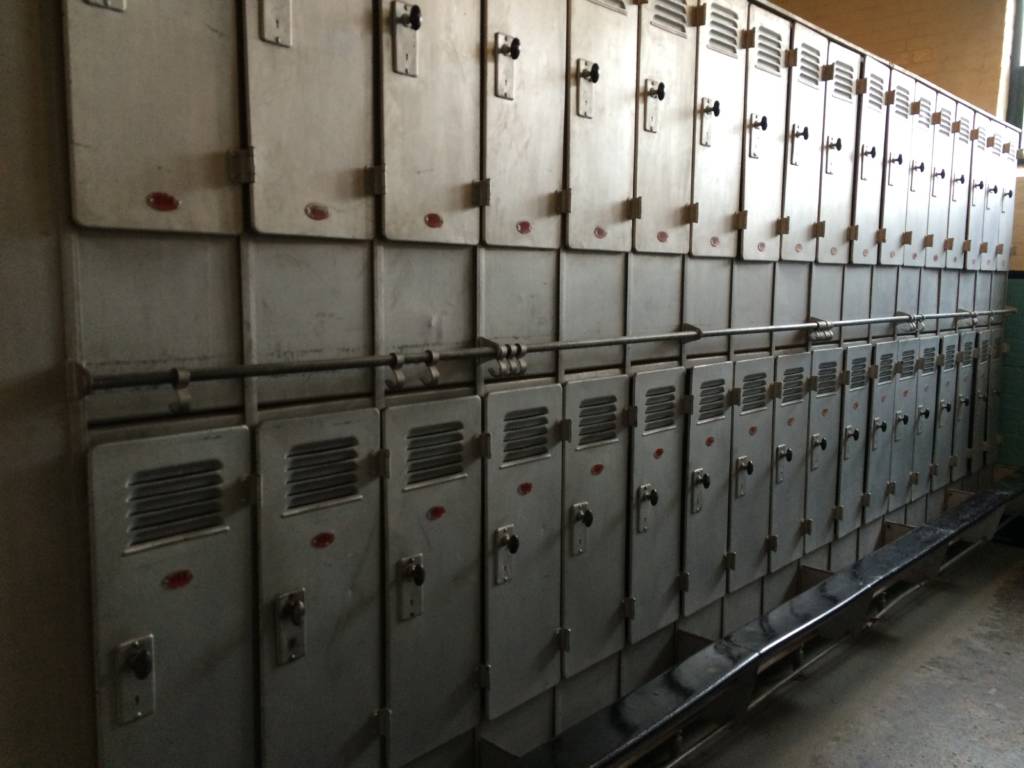
They were ready for us now, he said. As our group descended the metal stairs from the slick, modern room into a more austere warehouse-sized space, I noticed the orderly piles of helmets arrayed on a long table with headlamps and web belts. And also, those canteen-like canisters I recognized from the video as re-breathers. It was quaintly haunting, I thought, this deliberate recreation, but then I began to realize what was afoot and wondered how I had missed it. When we were told that no cell phones and cameras would be allowed because of batteries, sparks, etc., it set in. A bag was passed around; we could retrieve our belongings later. The helmet on my head, its lamp, and the belt I was cinching around my waist were not for dress-up.
I had never been in an elevator without walls; the utilitarian ideal: little more than a floor under the feet. When you’re in a cage and not encased in the comfort of a well-lit, brushed steel or cherry-paneled cubicle, you can watch the dark, damp walls of the shaft passing by until the light disappears altogether. You notice the rattling, clacking of metal on metal, the throb of tension in the cables that for every other elevator ride of your life had always been muted. The overpowering smell of the earth itself is new, too, a smell of stone, more enigmatic and timeless than the cool, sanitary concrete of a new basement, or subway tunnel’s urban breath. Perhaps I was daydreaming when the claustrophobes had been warned and prudently self-ejected from the expedition, but soon our crew was at the bottom of the shaft, debarking the crude elevator.
At some point, creeping behind our guide along a particularly low tunnel, I realized I was the laggard in our single file. Three hundred feet might not seem such an adventurous depth, but then, isn’t the idea of six feet of earth overhead enough to stoke a pulse of anxiety in your temples? People weren’t saying much, but from their hushed and unconvincingly relaxed British quips, I figured my wife and I were the only Americans. Told to mind our heads, we walked with knees bent. I passed timbers (yes, timbers) with restraint, reluctant to extend a steadying hand for fear of knocking one out of position and bringing the place down.
When I was about nine or ten, a man in our neighborhood on Long Island used to set up a 16mm projector on the beach, its accompanying screen hoisted near the tideline so that the community could watch a film against the backdrop of the bay at night. These were mostly horror movies, made more bearable by the sea. We endured jolts of cheap fear in our army blankets while an outboard with running lights slapped across the waves behind the crazed eyes of Vincent Price or Peter Lorre. It was often hard to concentrate out there, but one movie—without either of those icons—defied the distractions of the moon, gnats, rogue firecrackers, or the orgiastic bonfire party of teenagers over the next dune. Premature Burial (1962) was based on Poe’s short story of the same title. For years, I couldn’t shake the memory of Ray Milland’s character Guy Carell waking from his cataleptic state to find he’d been buried alive. It stuck with me through junior high. Inevitably, my dread mellowed to bemused denial, then disdain for my former self, especially when Aliens supplanted woodenly acted, gothic camp with genuine horror. I hadn’t thought about Premature Burial for decades. Until Blaenavon.
It was a place that chided memory, demanded comparison. Trying to picture the scene of all those people and animals toiling down there over the centuries was a mythologist’s exercise: to restore with one’s imagination the torture chamber diorama of a cathedral tympanum come to life. Tolkien had it right, too, his Orcs swarming in Mordor, fabricating their war tools inside a mountain’s cavernous bowels. But this coal mine was too cramped for that. I was reaching for anything to explain what I was feeling down there… anything except for what was actually happening. Gaining traction was the solipsistic metaphor of my own family situation: the suffocating prison of unrealistic expectation to which my mother and sisters had relegated me after my father died almost two decades ago. It was pathetic. Descents of any sort—personal, historic, and artistic—compel us to swerve from the literal. Although our visit to Wales was during Obama’s second term, it now also seems like an oracular vision of our journey into some underworld of national identity just around the bend with Donald Trump.
The personal essay often demands that the writer strive for parallelism, to construct in the ether of the creative process a reliable suspension bridge from the immediate or interior to the universal, or, from the cosmic to the intensely human. After sorting through all of my figurative shenanigans, recalling that excursion of a few summers ago can do nothing but underscore its horrible and concrete essence. The intensity of confinement was at once excruciatingly personal and self-obliterating. I was with other people, within a few inches of my wife; we could have held hands. Yet, I’d never felt more helplessly alone, a marooned, living consciousness with memory and emotion intact, but a body that wasn’t going to do me any good. We had just obeyed our guide’s request for silence and to kill our lights so that we might appreciate the real darkness, the situation that miners endured day after day, year after year. My senses’ sleight of hand was working overtime, my brain fighting to transcend what was overhead—the weight that might be space, now that I couldn’t see it. It was almost unbearable. I was too aware of what was up there on the other side of that dense, undeniable barrier. As the seconds passed, though, I remembered that, indeed, I was squatting over a puddle in a tunnel. And, yes, that faint sound of groundwater trickling down the walls I also couldn’t see was a message from the surface world, a liquid rope of existential rescue. It had been rain, once, plummeting from thousands of feet to make the hills green.
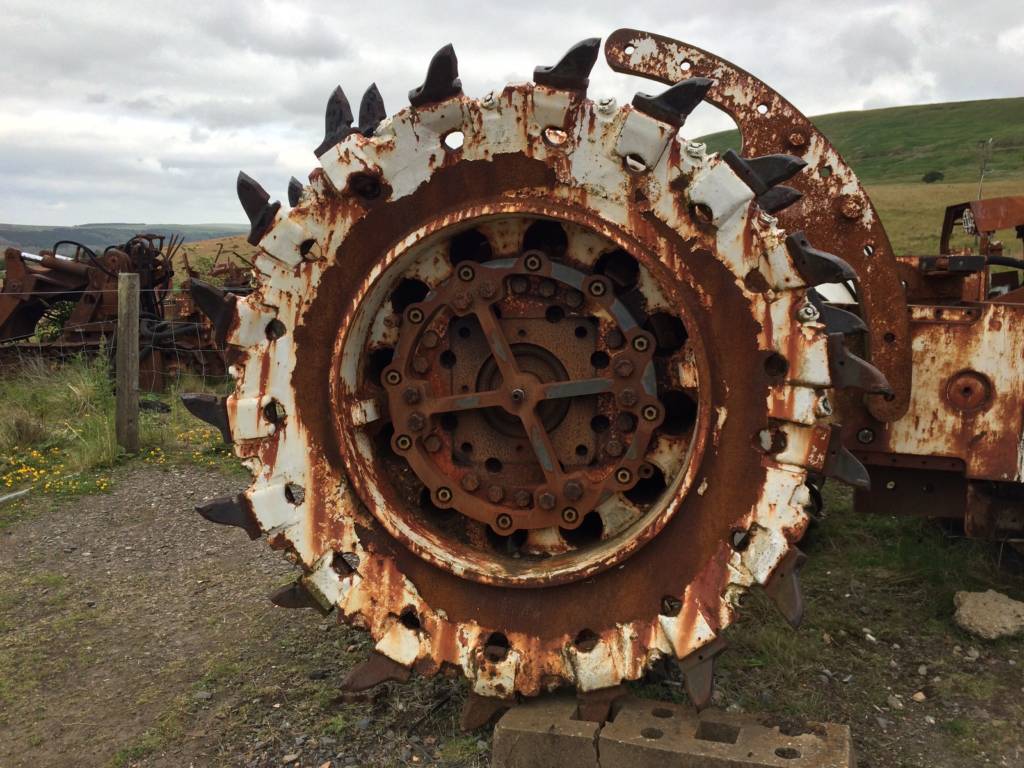
Blaenavon, a World Heritage Site, is the ossified heart of the industrial revolution, a principal source of coal for the furnaces that churned out the metal for weapons that would kill nearly twenty million soldiers and civilians in World War I. By 1918, the mine employed about a thousand people, so one can only imagine the undocumented psychological casualties beyond the deaths due to regularly occurring accidents (at least a hundred before the end of the 19th century). Children were down here too, of course, hoisted back to starlight after a day of having their wrists tethered to the knobs of tunnel doors so that they couldn’t wander off. Their job was simple: to wait in the darkness, anticipating the approach of tool-clatter and hooves in the glow of a swinging lantern. Like human valves, their operation of the doors prevented gasses from traveling from chamber to chamber. Explosions could be confined. I imagined them sliding from their chairs, following the string to the door handle, swinging the passage open, watching a horse’s flank, the benediction of its black eyes, then yanking it shut, to sit back down and wait again in the wordless dark. As we were at that very moment. All mining tours are exercises in empathy.
I still get emails from The Lion Inn, the “best” hotel in Blaenavon, where we stayed for two nights. Though we were the only guests, the local population seemed well represented in the inn’s restaurant: an eightieth birthday party (had the star of the show been a miner?); a rambunctious and loud girls’ night out; a young couple not making eye-contact, chugging white wine, prodding their shared shepherd’s pie; a few smokers cradling pints on the sidewalk. Something keeps me from relegating those ads and missives to the spam box, but it’s not the announcement for a “bangers and mash” special, the advertised two-for-one cocktails, the men’s a cappella group performing on Saturday night, or the promise of a new brewery opening in town. I can’t call it nostalgia. I’ll probably never go back there again. Perhaps it’s the weekly reassurance that normal, modern lives go on despite the dead honeycomb/ant farm a few hundred feet below, where I had hunkered, confused, pretending not to be a terrified tourist for an hour or so.
When I open those emails, I think of the beefy, tattooed guys we bantered with after the mine tour at another pub, The Queen Victoria, across town. One of them—a ubiquitous Jones, of course—offered my wife his barstool, which initiated a conversation and the public scanning of her family names: Evans, Howell. While their wives and children, familiar with the routine, smirked from a booth in the corner, the men boasted and argued melodramatically, one bellowing, “No! I’M the last miner of Blaenavon!” Though he was barely old enough to have been born before the mine shut down. I admired their blasphemy and indiscretion, maintaining the joke as a kind-hearted mockery of local folklore as they intermittently checked their phones. Among them: a car mechanic, a builder, a guy who fixed computers, and a website designer.
The day before, out walking, we had asked a kid where the town’s memorial to the Great War was. He said he was pretty sure they didn’t have one. They did, and we found it by accident after walking on a few blocks. It was a clock tower, a modest cenotaph of stone and bronze about twelve feet high that also listed the men and women killed in the following World War, Korea, and The Troubles. The impassive timepiece, set on a carefully landscaped floral slope behind an iron fence, stood cold as a giant drill parked in a field.
Sometimes, I find myself back in the mine when I least expect it. At my desk in the fluctuating drudgery and reward of grading papers, revising a syllabus, or just standing at the window looking out at nothing, dreaming of exercise, of getting in the water, of better weather. Of doing something else. Or, even today, reading in The New York Times that Wales is considering a ban on the physical punishment of children. During moments like these, I return to the stables underground, too, which really moved me. Especially after the tour guide told us that some of the “pit ponies” working in the mine were born, raised, and died there. Why do I feel so sorry for them? How could they crave what they never knew, living and perishing so far down? My headlamp beam had scanned their troughs then jerked up to the names ignited and rearing above the empty stalls, heroic, mythic, human: Endeavor, Titan, Mike.
Ralph Sneeden’s poems and essays have appeared in AGNI, Ecotone, Harvard Review, The Kenyon Review, The New Republic, Ploughshares, The Surfer’s Journal, and many other magazines. The title poem from his book, Evidence of the Journey, received the Friends of Literature Prize from Poetry magazine. “Blaenavon” is the anti-thesis in his manuscript, The Legible Element: Essays On (and In) Water. He was born in Los Angeles and teaches in New Hampshire at Phillips Exeter Academy.
